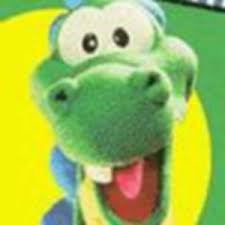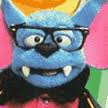 I'm going to be straight with you on this one and let you in on a little secret: kids love puppets. The muppetier, the better. It's a tried-and-true formula, and it works. The best thing about puppets is that they can do things that make absolutely no sense and have no groundings in real behavior of human beings, but we accept it as puppet doctrine due to their hypnotizingly vacant googly eyes. The puppets in Eureeka's castle were particularly adept at allowing children to be "in" on their jokes, hence allowing children to bask in their perceived percipience at preemptively predicting the punchline.
I'm going to be straight with you on this one and let you in on a little secret: kids love puppets. The muppetier, the better. It's a tried-and-true formula, and it works. The best thing about puppets is that they can do things that make absolutely no sense and have no groundings in real behavior of human beings, but we accept it as puppet doctrine due to their hypnotizingly vacant googly eyes. The puppets in Eureeka's castle were particularly adept at allowing children to be "in" on their jokes, hence allowing children to bask in their perceived percipience at preemptively predicting the punchline.Our cast of characters was small but lively. Unlike other puppet shows like the Muppets, Eureeka's Castle was a distinctly enclosed environment with little to no contact to outside puppets. The show was based in a wind-up music box maintained by a genial giant and featured an unlikely gang of magical and mythical pals.
Eureeka's Castle's quirky characters each possessed some oddity or foible that was both completely insane and instantly recognizable by child viewers. The show was smart enough to present its characters in single dimensions, giving each puppet an apparent schtick from which to extrapolate wacky plot lines. Let's take a closer look at our castle players:

Eureeka, our show's beloved heroine and namesake. Notice the adorable My Little Pony-hued hair. Don't you just want to brush it with a tiny pearlescent pony mane brush? Also, she seems to have pastel croissants sprouting from either side of her head. I like to imagine that she got into some sort of a scuffle with an angry pâtissier. Anyway, Eureeka is a student sorceress with hilarious incantations-gone-awry a la Elizabeth Stevens. Despite her notably amateurish attempts at sorcery, she has a certain charm only found in someone who grows up in a wind-up music box.
 Magellan, our lovably clueless dragon friend. It only makes sense that he was named after a Portugese maritime navigator, because it has absolutely nothing to do with who he is as a character. Magellan (again, the dragon, not nautical explorer) tends to get overexcited and lose control of his unwieldy tail, as one is wont to do with highly dangerous appendages. His single-toothed smile is undeniably lovable, if a bit unfortunate. Magellan seems to have some sort of music box allergy, causing him to sneeze with such fervor that their entire encapsulated wind-up world shakes violently.
Magellan, our lovably clueless dragon friend. It only makes sense that he was named after a Portugese maritime navigator, because it has absolutely nothing to do with who he is as a character. Magellan (again, the dragon, not nautical explorer) tends to get overexcited and lose control of his unwieldy tail, as one is wont to do with highly dangerous appendages. His single-toothed smile is undeniably lovable, if a bit unfortunate. Magellan seems to have some sort of music box allergy, causing him to sneeze with such fervor that their entire encapsulated wind-up world shakes violently. Batly, our near-blind bespectacled bat friend, known for his hilarious and unsuccessful flying attempts. As children, we could endlessly annoy our parents by jumping from high, precarious pieces of furniture and recovering with Batly's witty catchphrase, "I meant to do that!" Oh, how we loved that catchphrase! Obviously, he had not meant to do that, yet he had done it regardless. Batly, you jokester. We forgive your klutziness, if only for your good humor and quotability.
Batly, our near-blind bespectacled bat friend, known for his hilarious and unsuccessful flying attempts. As children, we could endlessly annoy our parents by jumping from high, precarious pieces of furniture and recovering with Batly's witty catchphrase, "I meant to do that!" Oh, how we loved that catchphrase! Obviously, he had not meant to do that, yet he had done it regardless. Batly, you jokester. We forgive your klutziness, if only for your good humor and quotability.

Bog and Quagmire, our Moat Twins, who in the above photos had to be tragically and sloppily cropped from a VHS cover group photo as they seem not to exist on the internet. They look sort of like uglier, messier, hyper-colored Elmos. They live in some unexplained banished habitat beneath the castle. Most of their time is spent ravenously consuming peanut butter sandwiches and playing rousing games of tag.

Mr. Knack, who has met a similar internet fate of virtual (forgive the pun) anonymity. Mr. Knack was some undisclosed class of foreigner and ran (as foreigners tend to do) a pushcart selling assorted goods.
For all you non-visual learners out there (read: the length of search for these images exceeds my allotted blogging timeslot) we also have Magellan's pets: Cooey, who was possibly some form of wild undomesticated Furby, and the Slurms, who were claymation dots. As a child terrified of all things claymated, even I could sit through the blobbish Slurms' mesmerizing recombinations of interesting colorful shapes and representations.
The aspect of the show that I remember most was the singing stone fish on the facade of the castle. I tirelessly searched for a visual of these gilled serenaders because I am determined to jog your memory, no matter to what lengths the internet goes to thwart my well-intentioned efforts. It appears that these fish have been since expunged from our collective memory as 90s children, so I wish to refresh it with the following image. I apologize for their Christmas hats--those aren't a standard singing fish feature, but is likely the only known Eureeka's Castle Fish photo on the entire interweb.

So there you have it: Eureeka's Castle. Sure, it was arguably a rip-off of the immediately preceding Nickelodeon show Pinwheel, but we loved it with equal and abundant vehemence nonetheless. Eureeka's Castle executive producer Kit Laybourne summed it up best when he explained their three hypothesized ingredients to effective humorous children's programming: wordplay, sight gags and/or physical comedy, and running jokes. With these simple elements, Eureeka's Castle created kid's programming that kids could not only understand but could simultaneously feel "in the loop" on the character's private jokes. Though Laybourne never directly addressed the question of his intentions, we as children in the 90s can easily speculate his answer.
He meant to do that.
Listen to the theme song to revive Eureeka's Castle memories






0 comments:
Post a Comment